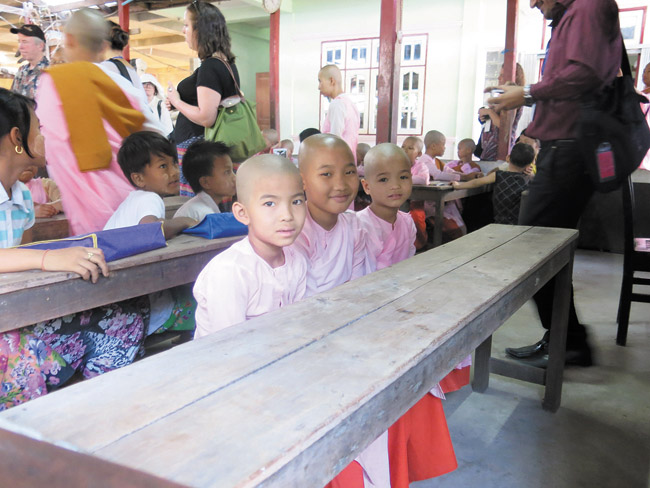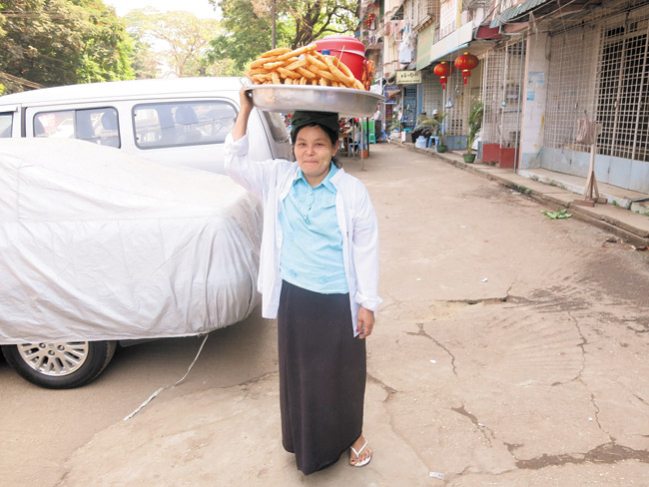Scarred But Hopeful In Myanmar
This is the third in a three-part series.
The long-suffering people of Myanmar see their military rather differently from the way we Americans tend to regard our servicemen and women. After five decades of brutal military dictatorship that ended in 2011, during which the generals became incredibly wealthy while bringing the nation’s economy to its knees, there isn’t much talk in Myanmar about “the courage and sacrifice of our troops” or of “the brave men and women in uniform.”
When people in Myanmar see a person in uniform, they see a collaborator in violently quashing a peaceful uprising led by Buddhist monks in 2007 – spurred by sudden, dramatic increases in the cost of everything from rice and eggs to gasoline. They see the face of a government that looked the other way, as if it hadn’t happened, when Cyclone Nargis killed at least 138,000 and left 2 million homeless in 2008. And they remember it was the military that shot dead more than 3,000 demonstrators during student-led protests in 1988, jailed many more and caused some to take to the jungle, where it’s said scores died from disease and lack of food and water.
One of those students was Aung Naing Oo. Call him the man who came in from the jungle. Today, he is Myanmar’s associate director of the Peace Dialogue Program, negotiating with ethnic groups – Karen, Mon, Kachin and many others – that have battled the government for generations, seeking greater rights as well as better services, such as electricity and radio on a regular basis, and paved roads.
Aung Naing Oo was a member of the All Burma Federation of Student Unions (ABFSU) that led those protests, known as the 8888 Uprising because it began Aug. 8, 1988.
“I understand the position of the ethnic groups,” he said at the East-West Center-sponsored International Media Conference in Yangon, which drew more than 400 people from 31 countries. “I was one of those who went to the jungle” to avoid being jailed or shot.
He is in many ways a symbol of the new Myanmar, scarred but hopeful that – as one conference panelist put it – “the genie of freedom and democracy cannot be put back into the bottle.”
Why the uncertainty about the future? Under the new constitution, the military gets 25 percent of legislative seats – local, state, national – and thus with its allies has blocking power. Changing the constitution to limit the military’s role is the goal of many in parliament during the next 18 months.
(Another former ABFSU leader, Nobel Peace laureate Aung San Suu Kyi, spoke at the conference’s opening luncheon, announcing a new Hawaii-based foundation focused on health and education in Myanmar. You can read about that online in a story by my Star-Advertiser colleague Craig Gima.)
Mr. Oo is just one of the many fascinating people I met at the conference – including two journalists who paid dearly for doing good journalism.
Roxana Saberi, an American whose father is Iranian (and her mother Japanese), was producing TV features from Iran for a variety of news outlets when she was arrested in 2009 and charged with espionage. “They said, ‘You are traveling all over the country asking many questions of many people – you must be a spy,'” she said. She was not allowed an attorney at her trial, and was sentenced to eight years in prison. Fortunately, so to speak, she spent just nine months behind bars before an international outpouring of support prompted the Iranians to release her. She wrote the book Between Two Worlds about that experience, and today the former collegiate soccer player and one-time Miss North Dakota is reporting for Al Jazeerah America.
Then there’s Umar Cheema, a correspondent for The International News of Islamabad, Pakistan. His reporting angered some in the government, and one night in 2010 he was abducted from his home, leaving behind a young son and pregnant wife. “All I could think,” he said, “was I hope to see my family again.” Blindfolded, he was taken to a place where he was stripped, his body shaved (great shame for a Muslim man) and severely beaten. Photos were taken of him, and his abductors vowed they would post the photos online if he were to continue writing such things. So what did Umar do? He went to his newspaper and wrote the story of what had happened to him, and continues to write stories critical of the government. I wondered if I could do that, and hopefully in America will never have to find out.
Bravery has many faces. I met Steven Gan, editor-in-chief of the “malaysiakini” news website in Kuala Lumpur. About 20 years ago at the height of the generals’ power, he came to Myanmar under the guise of a computer salesman prospecting for business. Instead, through a friend, he arranged to meet Aung San Suu Kyi at the friend’s house. Steven arrived hours early. When Aung San Suu Kyi arrived, she was followed by a motorcade of army vehicles. Over the next few hours he interviewed her and got some photos. When she left, to his dismay, only half the soldiers followed. The rest waited to see who else might exit. Hours later, Steven and a friend made a dash for a car, and a desperate chase ensued. “I knew if they caught me, they’d take my tapes and film, at the least,” Steven said. At last he and his friend abandoned the car and ran: “I was wearing jeans, and at that time I was probably the only guy in the country wearing jeans, so I was easy to spot.” They ducked into a shop and Steven bought a longyi, the cotton skirt favored by Myanmar men, and made his escape.
The old regime was so repressive, by the way (and as reported by Denis Grey in Bangkok Airway’s in-flight magazine), that after the generals built the new capital Nay Pyi Taw in the middle of nowhere (far from the street protests of Yangon) and moved animals from the Yangon Zoo there, a Myanmar comic quipped, “Now all the animals in Myanmar are at Nay Pyi Taw.”
He was promptly jailed.







